Fellow knife enthusiasts, listen up! Have you heard of ATS 34 steel? Is ATS 34 steel good for knives? As a seasoned steel aficionado, I’ve spent countless hours flipping, sharpening, and testing blades crafted from this enigmatic alloy. While I won’t spoil the surprise just yet, let me tell you, this steel is more than just a catchy name.
Spoiler alert: it’s no marketing gimmick. ATS 34 boasts razor-sharp edges, smooth slicing, and legendary toughness. But does it translate to real-world grit? Can it handle your daily grind or conquer outdoor adventures? Let’s dissect its strengths, weaknesses, and see if it deserves a spot in your knife arsenal. Buckle up, grab your trusty blade, and let’s unlock the secrets of ATS 34 steel together!
- What is ATS-34 steel?
- ATS-34 steel chemical composition
- ATS-34 steel hardness
- Properties of ATS-34 steel
- Is ATS-34 a stainless steel?
- ATS-34 Steel Equivalent
- Limitations of ATS-34 steel
- ATS-34 steel applications
- Comparison to other steels
- Is ATS-34 a good knife steel choice for you?
- Final words: Is ATS 34 steel good for knives?
What is ATS-34 steel?
ATS-34, a fine-grained Japanese steel alloy, boasts impressive qualities. It excels in resisting corrosion, holding a sharp edge, and being easy to sharpen. Its story starts with American 154CM steel, developed for demanding applications like jet turbine blades. This steel, in turn, evolved from 440C, a type of martensitic stainless steel with added molybdenum for toughness.
Seeking similar performance, Japan’s Hitachi Corporation created their own version: ATS-34. While 154CM waned in popularity, it saw a revival around 2006 as CPM 154, utilizing a powder metallurgy process for even better properties. Essentially, these three steels – 154CM, ATS-34, and CPM 154 – share the same core elements (carbon, chromium, and molybdenum) but differ slightly in origin and manufacturing methods.
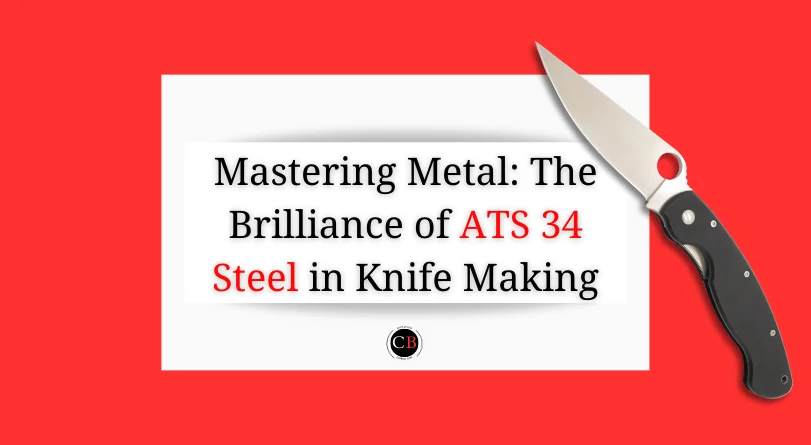
ATS-34 steel chemical composition
ATS-34 shines with its impressive blend of properties, and its unique chemical composition plays a key role. Let’s get into the core elements:
- Carbon (C): 1.05% – This primary contributor enhances hardness, wear resistance, and strength, making ATS-34 a reliable performer.
- Chromium (Cr): 14.0% – The star of the show for rust resistance, this element forms a protective oxide layer, keeping your blade looking sharp and corrosion-free.
- Molybdenum (Mo): 4.0% – This element enhances tempering stability, meaning the steel retains its hardness even after exposure to high temperatures, crucial for maintaining sharpness.
- Manganese (Mn): 0.40% – Contributes to hardenability and toughness, ensuring the steel can withstand wear and tear without chipping or breaking.
- Silicon (Si): 0.35% – Acts as a deoxidizer, improving grain refinement and overall steel quality.
- Phosphorus (P): 0.03% – Minimizes embrittlement, ensuring the steel remains strong and flexible.
- Sulfur (S): 0.02% – Minimizes hot shortness, meaning the steel performs well during high-temperature shaping processes.
- Iron (Fe): Balance – The base metal that binds all these elements together.
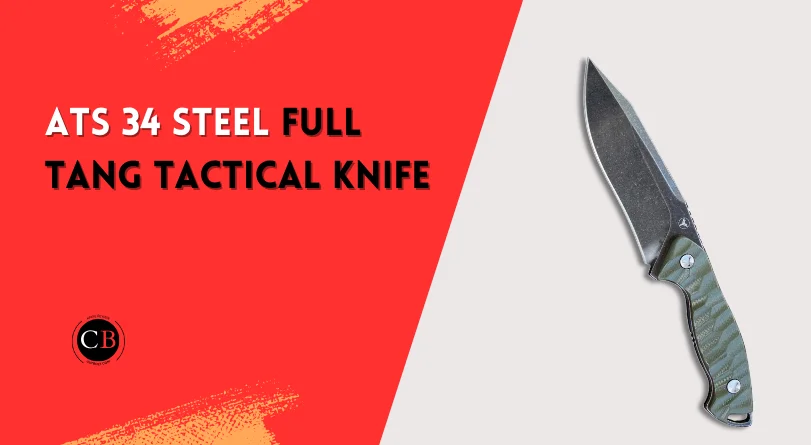
| Element | Weight Percentage (%) | Role in Steel |
|---|---|---|
| Carbon (C) | 1.05 | Hardness, wear resistance, strength |
| Chromium (Cr) | 14.0 | Rust resistance |
| Molybdenum (Mo) | 4.0 | Tempering stability, edge retention |
| Manganese (Mn) | 0.40 | Hardenability, toughness |
| Silicon (Si) | 0.35 | Grain refinement, steel quality |
| Phosphorus (P) | 0.03 | Minimizes embrittlement |
| Sulfur (S) | 0.02 | Minimizes hot shortness |
| Iron (Fe) | Balance | Base metal |
A slightly different composition is offered by Alpha knives supply, Hitachi itself is silent regarding the details.
As you can see, the chemical composition of ATS-34 is a mixture of high carbon (more than 1%) and high chromium (more than 12%), which makes it a stainless steel characterized by corrosion resistance and wear resistance.
ATS-34 steel hardness
Forget flimsy blades that dull quickly! ATS-34 steel packs a punch with a Rockwell hardness of 60-61HRC. This puts it in the elite league of high-quality knives, boasting exceptional edge retention. Imagine slicing through tasks with unwavering sharpness – that’s the power of ATS-34. But be warned, sharpening this beast requires a bit more effort compared to softer steels. Think of it as a trade-off: longer-lasting sharpness comes with a slightly steeper sharpening curve.
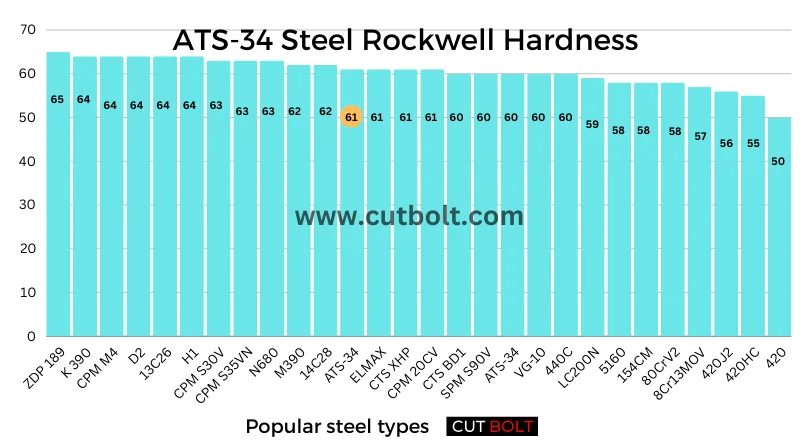
Properties of ATS-34 steel
Here are the properties of ATS 34 steel:
1. Edge retention
Ditch the whetstones! ️ ATS-34 slashes through the dullness competition with its unyielding sharpness and edge retention. Forget daily sharpening rituals – this steel lets you conquer tasks for days on end without worrying about a blunted blade.
The secret lies in its rock-hard composition. Imagine a microscopic army of atoms standing shoulder-to-shoulder, resisting wear and tear. That’s the power of ATS-34’s high Rockwell hardness, keeping your edge sharp and ready for action.
Sure, sharpening might require a tad more effort compared to softer steels, but the trade-off is clear: longer-lasting sharpness that lets you focus on the task at hand, not the tool.
2. Wear resistance
Here are some key points about the wear resistance of ATS-34 steel:
- ATS-34 is a stainless steel grade containing about 1.05% carbon and 14% chromium, making it highly resistant to wear and corrosion.
- The high chromium content enables ATS-34 to form a protective chromium oxide layer on its surface, providing excellent corrosion resistance. The carbon further enhances hardness and ability to resist abrasion.
- ATS-34 achieves high scores on the Rockwell C hardness scale (typically around 58-61 HRC), indicating it has very high hardness levels required to resist wear from friction, impacts, erosion, etc.
- The alloy has demonstrated exceptional edge retention and ability to maintain sharpness over extended cutting tasks. This makes it highly valued for applications like knife blades and surgical tools.
- Compared to other popular knife steel grades like 154CM and 440C, ATS-34 exhibits better wear resistance thanks to optimized levels and ratios of key alloying elements like carbon, chromium, and molybdenum.
- Testing shows it exhibits reduced loss of material over time during cutting use cases with various materials. This supports a longer usable life between resharpening needs.
ATS-34’s carefully balanced composition results in an outstanding stainless steel in terms of hardness, sharpness retention, and resistance to abrasion and adhesive wear during cutting or high-friction use cases. This produces exceptional longevity and performance.
3. Decent toughness
Despite its impressive hardness, ATS-34 boasts decent toughness, handling most tasks without chipping or breaking.
4. Excellent corrosion resistance
ATS-34 shines, thanks to its impressive rust resistance. Boasting a chromium content of 14%, this stainless steel stands as a favorite for camping, hunting, and even kitchen knives. While highly resistant to stains, corrosion, and rust, remember – proper care is still key to maximizing its longevity.
5. Sharpenability
Sharpening an ATS-34 blade isn’t a walk in the park – its high hardness means it requires more effort than softer steels. Field sharpening might be tricky, but compared to other high-performance steels, it’s less daunting. With proper tools and technique, home sharpening shouldn’t be an issue. Consider it a trade-off: longer edge retention demands a bit more sharpening TLC.
Is ATS-34 a stainless steel?
No ATS-34 is officially not a stainless steel. While ATS-34 boasts an impressive 14% chromium content, exceeding the minimum requirement for “rust-free” steel (10.5-13%), it technically falls short of being classified as true “stainless steel” due to 0.03% phosphorus content.
Here’s why:
- Chromium: Check! With 14% chromium, ATS-34 offers excellent rust resistance, comparable to many stainless steels.
- Sulfur and Phosphorus: Not quite! These “iron companions” play a crucial role in stainless steel classification. While ATS-34’s sulfur content (0.02%) meets the 0.025% limit, its phosphorus content (0.03%) slightly exceeds it.
So, while highly resistant to rust, ATS-34 doesn’t meet the precise chemical composition requirements for “stainless steel” due to its slightly higher phosphorus content.

ATS-34 Steel Equivalent
154CM steel is the equivalent of ATS-34 steel. Developed in the US, this steel served as the blueprint for ATS-34. Remember? ATS-34 Japanese steel was developed as the Japanese version of the US 154CM steel. Both share similar chemical compositions, rich in carbon and chromium, resulting in excellent performance and popularity in knives.
The Upgraded Cousin: For enhanced hardness and wear resistance, consider CPM 154 steel. This powder metallurgy version of 154CM inherits the core elements but adds vanadium and tungsten, boosting its toughness and edge retention.
Limitations of ATS-34 steel
While highly resistant to rust, ATS-34 isn’t the absolute champion in the corrosion game. For environments with prolonged wet or salty exposure, other steels like Japanese H1 or European LC200N might be better suited (manufactured by ZAPP).
However, where ATS-34 shines is in custom knife making. Its alloy composition demands higher heat treatment temperatures, but when done right, it rewards you with an exceptionally sharp and durable edge.
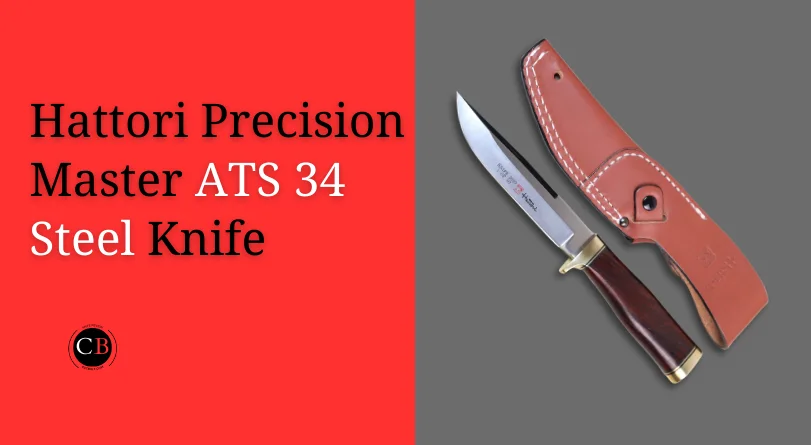
ATS-34 steel applications
Despite rising competition from newer steels, ATS-34 remains a stalwart in the knifemaking world. Beloved by artisan and industrial cutlers alike, it held the “standard for knife steel” title for over a decade. While newer options may offer specific advantages, ATS-34’s established reputation, proven performance, and vast user base ensure its continued presence for years to come. Marketing might play a role, but ultimately, its enduring popularity rests on its inherent qualities and the countless knives it has helped create.
Comparison to other steels
ATS-34 vs S30V steel
ATS-34: A veteran in the knife world, this Japanese steel boasts excellent sharpness and good edge retention. While not the absolute champion in corrosion resistance, it holds its own against most daily encounters. Beloved by many for its ease of sharpening, ATS-34 shines in the hands of both skilled craftspeople and everyday users.
S30V: This American-made premium steel caters to those who demand the best. S30V boasts exceptional edge retention, lasting longer between sharpening sessions. Additionally, its superior corrosion resistance provides peace of mind, especially for outdoor enthusiasts or those tackling wet environments. However, sharpening S30V requires a bit more effort due to its harder nature.
Choosing Your Champion: The ideal steel ultimately depends on your needs and preferences. If effortless sharpening is your priority, ATS-34 might be your perfect match. However, if you prioritize long-lasting sharpness and top-notch corrosion resistance, S30V might be the champion you seek. Remember, both steels offer exceptional performance, so the choice comes down to what matters most to you.
ATS-34 vs VG10 steel
ATS-34 provides excellent corrosion resistance, but VG10 surpasses it in this aspect, particularly renowned for its superior resistance and widespread use in kitchen knives. Additionally, VG10 boasts better edge retention compared to ATS-34, although its edge retention is akin to that of S30V. However, it’s worth noting that VG10 is more challenging to sharpen than ATS-34.
ATS-34 vs 440C steel
ATS 34 is superior to 440C because it has better edge retention and corrosion resistance. However, 440C steel knives are more affordable and slightly easier to sharpen.
Related: How good is AUS 8A steel for knives?
ATS-34 vs D2 steel
Here is a comparison between D2 and ATS 34 steel:
- Edge Retention: D2 reigns supreme with its exceptional hardness, translating to longer-lasting sharpness compared to ATS-34. This makes it ideal for demanding tasks where frequent sharpening isn’t an option.
- Sharpening: Brace yourself for a trade-off. D2’s hardness comes at the cost of significantly increased sharpening difficulty. Conventional methods like watered stones might leave you wanting, requiring advanced techniques and tools to achieve optimal sharpness.
- Corrosion Resistance: While both offer decent protection, ATS-34 edges out D2 with its higher chromium content (14% vs. 12%). This translates to improved resistance to rust and corrosion, especially for everyday use. However, both steels require proper care to maintain their shine.
Choosing Your Champion: The “better” steel ultimately depends on your priorities. If uncompromising sharpness and long-lasting edge retention are paramount, and you possess advanced sharpening skills, D2 might be your perfect match. However, if ease of maintenance and slightly better corrosion resistance are more important, ATS-34 could be the wiser choice. Remember, both steels excel in different areas, so the best pick depends on your individual needs and preferences.
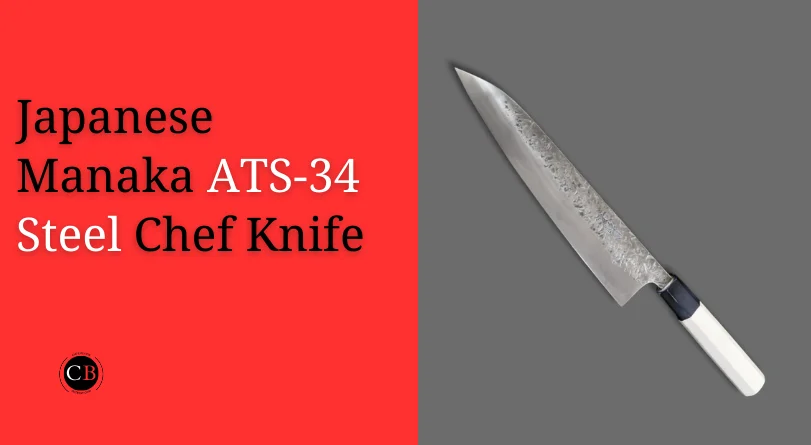
Is ATS-34 a good knife steel choice for you?
Absolutely! ATS-34 boasts a stellar reputation for several reasons:
- Exceptional Edge Retention: It holds its sharp edge for a long time, perfect for tasks where frequent sharpening isn’t feasible.
- High Toughness: This steel can handle tough jobs without chipping or breaking easily.
- Good Balance: It strikes a sweet spot between edge retention and sharpenability, making it versatile for various uses.
Where you’ll find it:
- High-end kitchen knives: Its performance and easy maintenance make it a favorite among professional chefs.
- Outdoor knives: Its toughness and edge retention shine in demanding conditions.
- Custom knives: Many knifemakers appreciate its versatility and performance.
A word of caution:
- Availability: Unfortunately, finding ATS-34 knives is becoming increasingly difficult due to import costs.
- Price: It’s considered a high-end steel, so expect to pay a premium for its qualities.
Alternatives:
While ATS-34 remains an excellent choice, newer “super steels” offer similar or even better performance. The best choice depends on your specific needs and budget.
Overall:
If you’re looking for a durable, sharp, and versatile knife steel, ATS-34 is still a fantastic option despite its decreasing availability. Just be prepared for a higher price tag and potentially longer search for the right blade.
Final words: Is ATS 34 steel good for knives?
ATS-34 occupies a unique space in the knife world. This “old-timer” boasts a stellar reputation for edge retention, toughness, and versatility. It’s a favorite among chefs, outdoor enthusiasts, and custom knifemakers alike. However, times change, and newer “super steels” emerge.
While ATS-34 still delivers exceptional performance, finding it at a reasonable price, especially for smaller artisans, can be a challenge. The choice boils down to priorities: Do you value proven performance and a classic feel even at a premium? Or are you drawn to the latest innovations and potentially better edge retention offered by newer steels?
Ultimately, ATS-34 remains a strong contender, especially if you prioritize reliability and time-tested quality. But keep in mind the evolving landscape and carefully weigh your options before making your decision.



